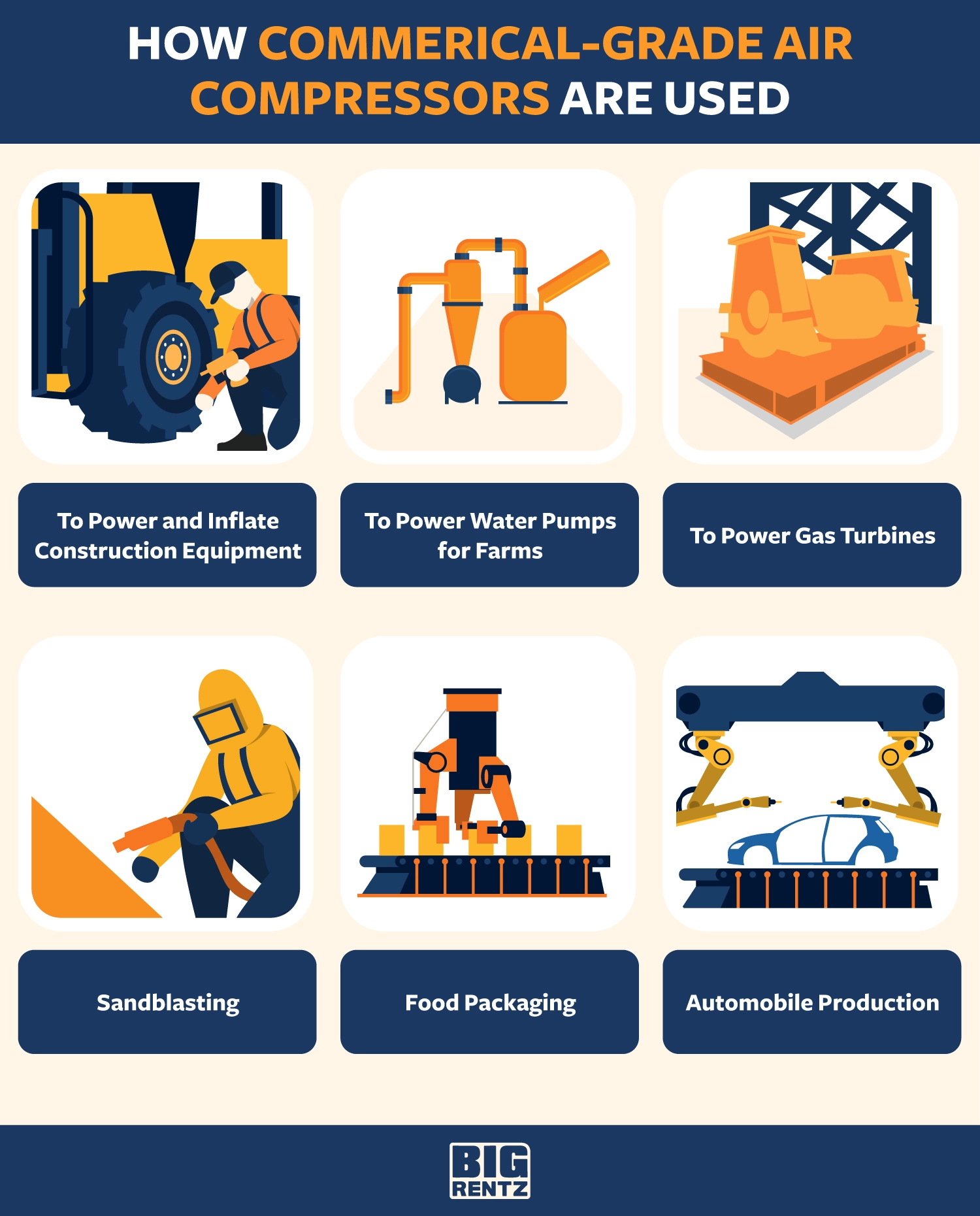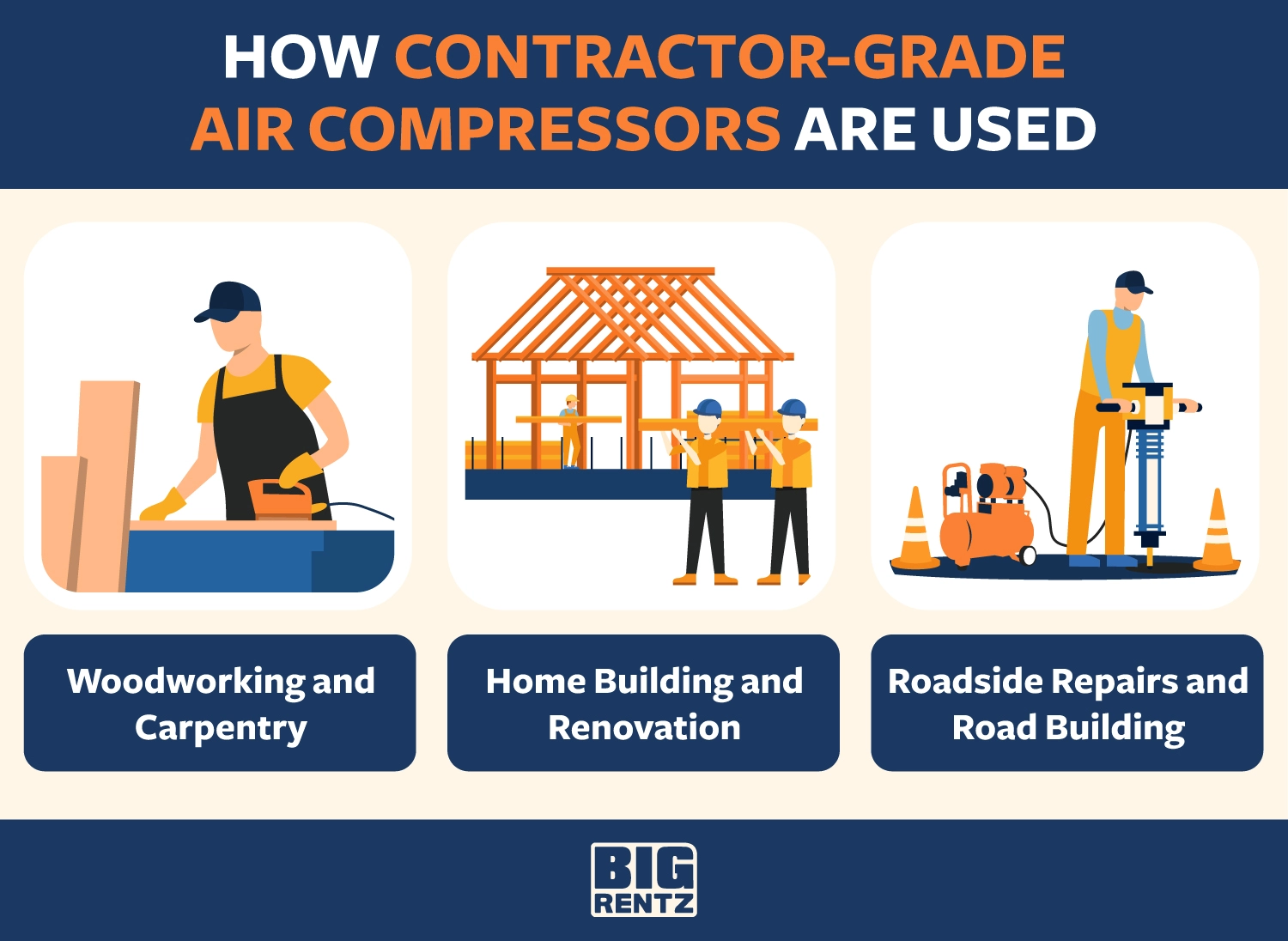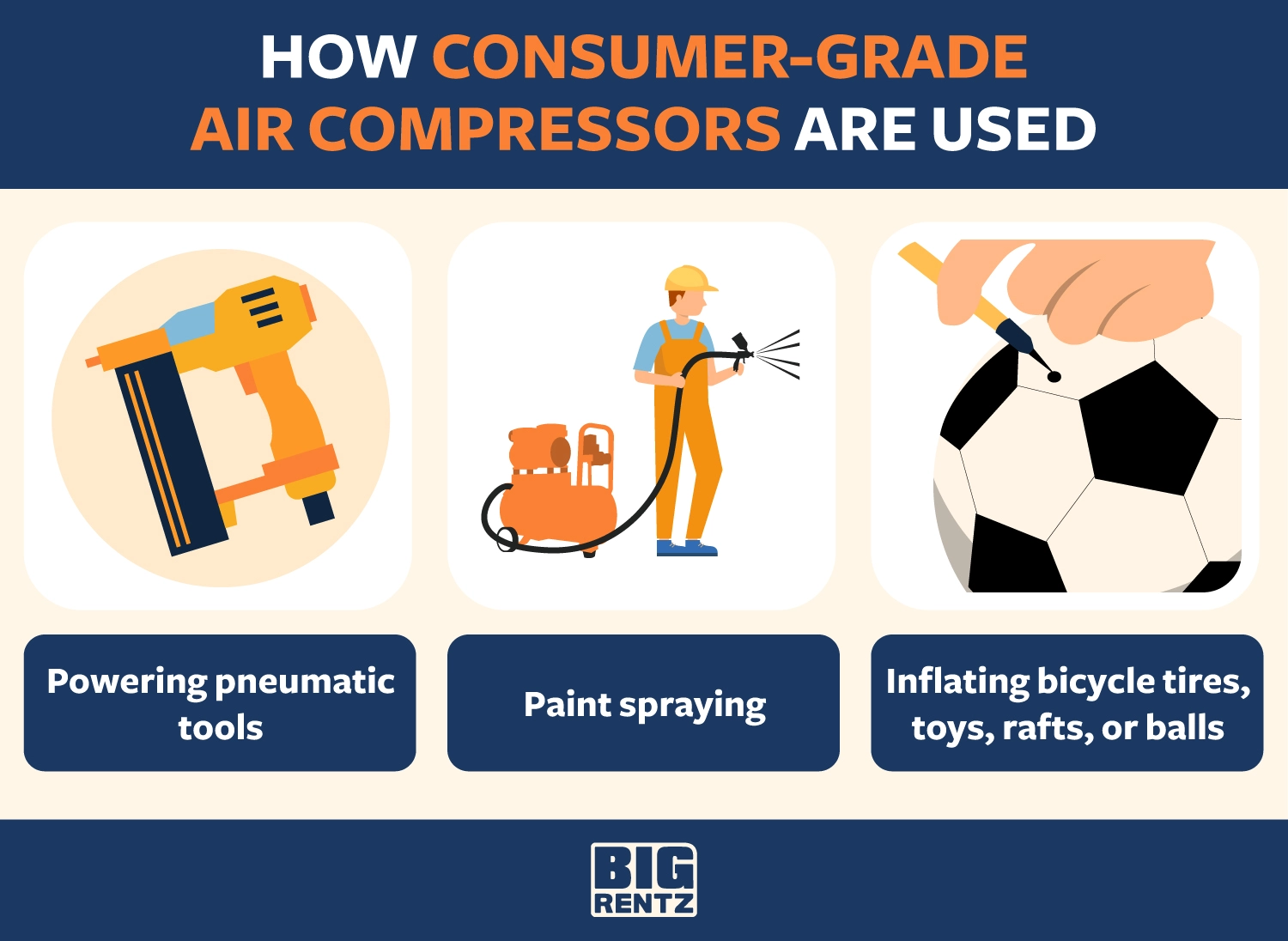An air compressor is a pneumatic device that can power a variety of tools. Air compressors work by putting atmospheric air under high pressure, “compressing” the air and converting its potential energy into kinetic energy that it stores in an air tank for use.
Some of the most common uses of air compressors are in everyday items like refrigerators, air conditioners, and vehicle engines. In construction, they’re used in a variety of different tasks and settings, like inflating tires and powering HVAC systems, air tools, and industrial systems.
In this guide, we go over common air compressor uses and how to find the best air compressor for your needs.
Explore All Air Compressors
Table of Contents
- Grades of Air Compressors and Their Uses
- How Commercial/Industrial Air Compressors Are Used
- How Contractor Air Compressors Are Used
- How Consumer Air Compressors Are Used
- What Air Compressor Size Do You Need?
- Types of Air Compressors
- Need to Rent a Towable Air Compressor?
Grades of Air Compressors and Their Uses
There are three different grades of air compressors — commercial, contractor, and consumer air compressors.
- Commercial-grade air compressors are designed for construction sites and businesses like auto body shops and manufacturing facilities. Their capacity in terms of producing and storing compressed air is much greater than that of the other two grades, making them the best choice for daily or extreme use. They may also be referred to as industrial air compressors.
- Contractor-grade air compressors are meant for building professionals, a power source for pneumatic tools like nail guns. They’re made to accommodate larger air demands than consumer air compressors can.
- Consumer-grade air compressors are designed for use around the house, like inflating sporting goods or tires and other DIY projects. They’re usually single-stage or portable air compressors.
How Commercial/Industrial Air Compressors Are Used
Though air compressors of all grades are used in a variety of settings, you usually encounter the highest air demands in commercial and industrial environments. Here’s how commercial-grade air compressors are commonly used on those job sites.

1. To Power and Inflate Construction Equipment
Commercial air compressors can be used to inflate tires on construction equipment like forklifts, scissor lifts, and loaders. They can also be used to power pneumatic tools like jackhammers and nail guns.
2. To Power Water Pumps for Farms
Air compressors are used in the agriculture industry to power water pumps. Because water is an essential resource for crops and livestock, it’s important that the mechanism used to deliver water is effective and consistent. Air compressors can support water delivery systems and offer a backup method of pumping water in case of an emergency.
3. To Power Gas Turbines
Air compressors are often used in gas turbines to produce compressed air flow. The compressor brings air into the machine, pressurizes it, and then transports it into the combustor where it combines with fuel, generating power.
4. Sandblasting
Sand blasters clean abrasive materials that can be difficult to remove, like rust on metal. Compressed air is part of the mechanism these tools use to clean, providing some of the necessary force.
5. Food Packaging
In the food and beverage industry, air compressors are used in the packaging process. They can vacuum-seal products, sealing in freshness and preventing leakage and contamination.
6. Automobile Production
Air compressors have a variety of uses in automobile shops. In addition to being a component of many vehicles, they’re also used to inflate vehicle tires, in paint sprayers to airbrush vehicle bodies, and to operate equipment.
How Contractor Air Compressors Are Used
Contractor-grade air compressors have many similar uses to industrial machines — they’re just less powerful and used on a smaller scale. Here are some common uses for this grade of air compressor.

7. Woodworking and Carpentry
Many pneumatic tools are used in woodworking and carpentry. Air compressors power these tools in woodshops, assisting with cabinet and furniture construction.
8. Home Building and Renovation
Contractor-grade air compressors are designed for use by professional builders. Just as people in that profession can handle a variety of tasks, these air compressors are built for a variety of contracting needs. They’re used in many areas of home construction, from powering tools to landscaping to small-scale demolition.
9. Roadside Repairs or Road Building
Air compressors are also useful in roadside work. For example, they’re often used to power equipment like jackhammers to break up rocks and pavement, enabling road repair or construction.
How Consumer Air Compressors Are Used
Consumer-grade air compressors are designed for personal use. They’re usually portable and small air compressors that people use for tasks around the house, from routine chores to DIY construction projects. Here are some common uses of this grade of air compressor.

10. Powering Pneumatic Air Tools
Air tools are power tools that use compressed air as their main source of energy. In addition to commercial and construction sites, many people regularly use air tools around the house. These include drills, nail guns, caulk guns, air hammers, impact wrenches, and many other tools that require pneumatic air.
11. Spraying on Paint and Stain
Air compressors can be used to stain wood or paint a building, room, or projects outside like a mini-barn, deck, or fence. Compressors make quick work of covering more space easily and ensure you get an even coat when spray painting a surface or applying stain.
12. Inflating Bicycle Tires, Toys, Rafts, or Balls
Air compressors aren’t just limited to helping you do hard work — they’re also used in play. Consumer-grade air compressors can be used to inflate bicycle tires, sports equipment like basketballs and pool toys, and other inflatables like air mattresses.
What Air Compressor Size Do You Need?
Air compressor size is mainly calculated using requirements for cubic feet per minute (CFM) and pounds per square inch (PSI). CFM refers to the speed at which the air is delivered, and PSI refers to the level of pressure. Generally, you want to make sure that the air compressor you use has higher CFM and PSI capacities than the tools you’re trying to power with it.
Determine whether you’ll need the compressor to power one tool at a time or multiple tools at the same time. List out all of the air tools you intend to use, and then add up the total requirements based on their individual specs. You can usually find the specs for each tool labeled on the tool itself or in the owner’s manual.
The table below shows the average CFM rating for the most common power tools, assuming all devices operate at 90 PSI. Keep in mind that these are estimates, be sure to check your air tool’s CFM rating on your tool or in the owner’s manual.
| Air Tool | CFM Rating |
| Brad Nailer | 0.3 |
| Chisel | 3–11 |
| Cut-off Tool | 4–10 |
| Drill | 3–6 |
| Dual Sander | 11–-13 |
| Framing Nailer | 2.5 |
| Grease Gun | 4 |
| Grinder | 4–6 |
| Nibbler | 4 |
| Paint Brush | 4–11 |
| Ratchet | 2.5–5 |
| Riveter | 4 |
| Shear | 8–16 |
| Speed Saw | 5 |
| Wrench | 2.5–10 |
Once you identify the CFM you need, you’ll need to find a compressor with a large enough storage tank to power your tools. Air compressor tanks can hold anywhere from a few gallons to hundreds of gallons of air depending on the tank. Typically, pancake air compressors are ideal for homeowners, while industrial air compressors may be used to power heavier equipment.
Types of Air Compressors
In addition to the three main air compressor grades, there are also different types of air compressors. Here are some common types of air compressors and how they’re used.
Positive Displacement Compressors
This type of air compressor generates power by displacing outside air into its internal tank and slowly increasing air pressure.
- Rotary screw compressors: Rotary screw compressors generate energy through an internal rotor system, with two internal rotors spinning in opposite directions. The air gets trapped between them, building up pressure. These machines are typically large, with some models requiring lubrication and others running oil-free. They’re best for large-scale jobs on industrial sites, and can withstand continuous use.
- Reciprocating compressors: The internal mechanism of reciprocating compressors contains a piston inside of a cylinder to displace and compress air. They can be single-stage or multi-stage, with single-stage models handling low-pressure needs and multi-stage models having high-pressure and higher power capacities. These machines are best-suited for smaller scale projects like home renovations and aren’t designed for continuous use.
Dynamic Compressors
This type of air compressor generates horsepower by drawing in air with rapidly rotating blades and restricting it to build pressure.
- Axial compressors: Axial air compressors are the kind of machinery found in heavy-duty vehicles with high speed and efficiency needs, like ships and planes.
- Centrifugal compressors: Centrifugal compressors draw in air to slow and cool it, storing it to build up pressure. They’re typically used in high-demand settings like manufacturing facilities and chemical plants, and can reach up to 1,000 horsepower despite being relatively small machines.
Need to Rent a Towable Air Compressor?
If you’re in need of a towable air compressor for your next project, you’ve come to the right place. BigRentz offers a variety of air compressors, ranging from 185 CFM to 1600 CFM, so you can find the right equipment for the job.
Explore All Air Compressors